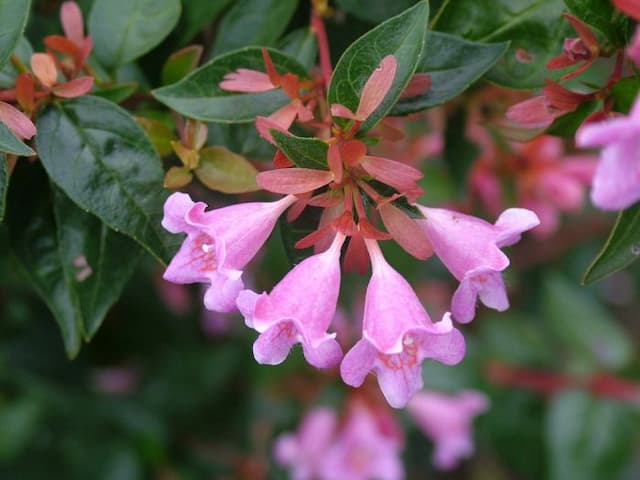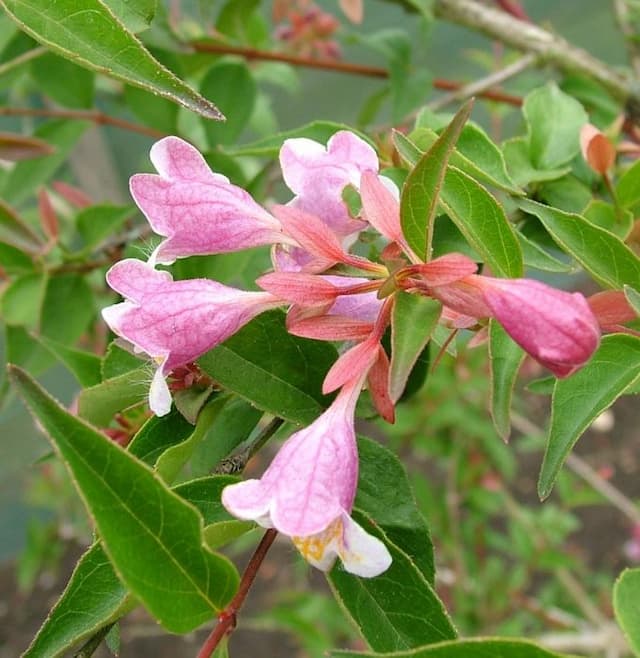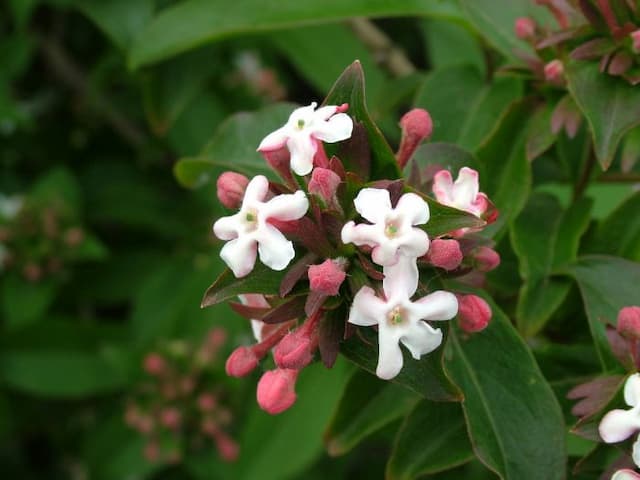Minuet Weigela Weigela 'Minuet'

ABOUT
Weigela 'Minuet' is a deciduous shrub known for its compact growth habit and charming floral display. The leaves of this plant showcase a mix of green and purplish hues which offer a rich backdrop for the flowers. During the blooming season, typically in late spring to early summer, Weigela 'Minuet' becomes a focal point with its trumpet-shaped flowers. The blossoms boast a gradient of color, ranging from a deep pink at the base, transitioning to a lighter pink, and eventually to almost white at the margins. These flowers are attractive to pollinators, such as bees and hummingbirds. The overall appearance of Weigela 'Minuet' is rounded and dense, giving it a pleasing form that complements many garden settings.
About this plant
 Names
NamesFamily
Caprifoliaceae
Synonyms
Minuet Weigela
Common names
Weigela florida 'Minuet'.
 Toxicity
ToxicityTo humans
The Weigela plant is not considered toxic to humans. Therefore, ingestion of parts of the Weigela typically does not lead to poisoning or adverse symptoms. However, it's always advisable to avoid eating ornamental plants as a general safety practice.
To pets
The Weigela plant is generally recognized as non-toxic to pets as well. It is not known to cause poisoning in domestic animals such as dogs and cats if they happen to ingest parts of the plant. Despite this, monitoring pets to prevent them from eating plants is always a good precaution.
 Characteristics
CharacteristicsLife cycle
Perennials
Foliage type
Deciduous
Color of leaves
Green
Flower color
Pink
Height
2-3 feet (0.6-0.9 meters)
Spread
2-3 feet (0.6-0.9 meters)
Plant type
Shrub
Hardiness zones
4-8
Native area
Asia
Benefits
 General Benefits
General Benefits- Attractive Flowering: Produces abundant trumpet-shaped pink to lavender flowers in the spring, attracting pollinators and adding aesthetic beauty to gardens.
- Compact Size: A smaller variety of Weigela, 'Minuet' is suitable for smaller gardens or limited spaces, making it versatile for different landscaping needs.
- Easy Care: Requires minimal maintenance, making it an ideal plant for both novice and experienced gardeners.
- Drought Tolerance: Once established, it has a degree of drought tolerance, reducing the need for frequent watering.
- Deer Resistance: Less attractive to deer compared to other garden plants, which can help in reducing damage from wildlife.
- Seasonal Interest: Offers multi-season interest with spring flowers, sometimes a lighter rebloom in summer, and attractive foliage that turns purplish-bronze in the fall.
 Medical Properties
Medical PropertiesThis plant is not used for medical purposes.
 Air-purifying Qualities
Air-purifying QualitiesThis plant is not specifically known for air purifying qualities.
 Other Uses
Other Uses- Weigela 'Minuet' can be used as a natural dye source for fabrics, giving them a soft, subtle color from its flowers or leaves.
- This plant's flexible stems can be woven into small garden structures or supports for other plants in the garden.
- With Weigela's propensity for attracting pollinators, it serves as an excellent companion plant in fruit and vegetable gardens to enhance pollination.
- The dense foliage of Weigela 'Minuet' can provide a private, green space when planted in groups, acting as a natural screen.
- Its branches, when pruned, can be used in floral arrangements, providing an attractive green backdrop for the flowers.
- Weigela 'Minuet' can be shaped into a low-growing hedge that borders pathways or defines different spaces in the garden.
- The dried leaves of Weigela can be included in potpourri mixtures, adding bulk and a soothing green hue.
- These plants can serve as a living mulch, their foliage helping to conserve soil moisture and prevent weed growth.
- Weigela 'Minuet' can be used in a rain garden setup that aims to prevent soil erosion and manage stormwater runoff.
- The vibrant springtime flowers of Weigela can serve as an inspiration for artists and photographers, being a subject for artwork and nature photography.
Interesting Facts
 Feng Shui
Feng ShuiThe Weigela is not used in Feng Shui practice.
 Zodiac Sign Compitability
Zodiac Sign CompitabilityThe Weigela is not used in astrology practice.
 Plant Symbolism
Plant Symbolism- Grace and Elegance: The Weigela 'Minuet' carries a refined beauty due to its delicate and proportional form, symbolizing a sense of grace and elegance.
- Endurance: As a hardy shrub that can withstand various conditions, Weigela 'Minuet' represents the ability to endure and thrive through challenges.
- Nostalgia: The plant can bloom with vintage-looking flowers, often evoking a sense of nostalgia or fondness for the past.
- Romantic Love: The soft, trumpet-shaped flowers may symbolize an expression of romantic affection, akin to a suitor serenading their beloved.
- Prosperity and Abundance: With its vigorous growth habit and profusion of blooms, the Weigela 'Minuet' can be associated with prosperity and an abundance of blessings.
 Water
WaterWeigela 'Minuet' should be watered thoroughly when the top inch of soil feels dry to the touch, typically every week during active growth in spring and summer, and less frequently during the dormant period in fall and winter. Use a gentle stream of water to soak the soil around the plant, avoiding wetting the foliage, with approximately 1 to 1.5 gallons of water for each watering session. During hot, dry spells, additional watering may be needed to maintain consistent soil moisture. It's important not to let the Weigela sit in waterlogged soil which can lead to root rot and other issues.
 Light
LightWeigela 'Minuet' thrives best in full sun to partial shade conditions. The ideal spot for planting would be a location where it receives at least 6 hours of direct sunlight daily. However, in areas with exceptionally hot climates, some afternoon shade can help prevent the foliage from scorching.
 Temperature
TemperatureWeigela 'Minuet' is hardy and can tolerate a wide range of temperatures once established; they are capable of surviving in temperatures as low as -20°F and can handle summer temperatures well over 100°F. The ideal growing conditions for this plant are in USDA hardiness zones 4 through 8, where the temperatures stay within this range throughout the year.
 Pruning
PruningWeigela 'Minuet' benefits from pruning to maintain its shape, encourage blooming, and remove any dead or damaged branches. Prune right after the Weigela finishes blooming in late spring or early summer, since it flowers on old wood. Remove up to one-third of the oldest stems to promote vigorous new growth and better flowering next season.
 Cleaning
CleaningAs needed
 Soil
SoilWeigela 'Minuet' thrives best in well-draining soil that is rich in organic matter with a slightly acidic to neutral pH range of 5.5 to 7.0. A soil mix with loam, compost, and peat moss can provide the appropriate structure and fertility.
 Repotting
RepottingWeigela 'Minuet' does not require frequent repotting as it is usually grown as a landscape shrub; however, if grown in containers, repotting every 3-5 years or when the roots outgrow the pot is sufficient.
 Humidity & Misting
Humidity & MistingWeigela 'Minuet' is adaptable to a range of humidity levels and does not require specific humidity conditions, making it suitable for typical outdoor garden environments.
 Suitable locations
Suitable locationsIndoor
Weigela 'Minuet' prefers outdoor growing; challenging indoors.
Outdoor
Plant Weigela 'Minuet' in sun or part shade and well-draining soil.
Hardiness zone
4-8 USDA
 Life cycle
Life cycleThe life of a Weigela 'Minuet', also commonly known as just Weigela, begins with seed germination, which typically occurs in spring or early summer when the soil has warmed. After germination, the plant enters a vegetative state where it develops roots, shoots, and leaves, gradually establishing itself as a small shrub. The Weigela then enters a period of growth and maturation, which can take several years, during which it increases in size and begins to form its characteristic bell-shaped flowers, usually in late spring to early summer. Following pollination, often by bees and hummingbirds, the flowers produce small capsule-like fruits containing seeds, completing the reproductive cycle. As a deciduous shrub, the Weigela 'Minuet' goes into dormancy in the fall, shedding leaves and entering a period of rest during the winter months. With the return of favorable conditions in spring, the plant breaks dormancy, resuming growth and starting the cycle anew.
 Propogation
PropogationPropogation time
Spring-Early Summer
Weigela 'Minuet', a deciduous shrub known for its trumpet-shaped flowers and compact growth, is commonly propagated through softwood cuttings. The ideal time to take cuttings for propagation is in late spring or early summer when new growth is mature enough yet still flexible. To propagate using this method, a gardener would cut a 4 to 6 inch (about 10 to 15 centimeters) length of stem from a healthy Weigela 'Minuet' plant, making sure that the cutting has several leaves. The lower set of leaves should be removed, and the cut end dipped in rooting hormone to encourage root development. The prepared cutting is then placed in a well-draining potting mix, ensuring that the leaf nodes where leaves were removed are buried in the soil. The pot should be kept in a warm, bright area, but out of direct sunlight, and maintained moist until roots have developed sufficiently, which can take several weeks. After rooting, the new Weigela 'Minuet' plants can be transplanted to their final location in the garden.








![Himalayan honeysuckle [Golden Lanterns]](/_next/image?url=https%3A%2F%2Fplants-admin.emdemapps.com%2Fimages%2Fplants%2F%2Fimages%2F604b55302cc87.png&w=640&q=75)
